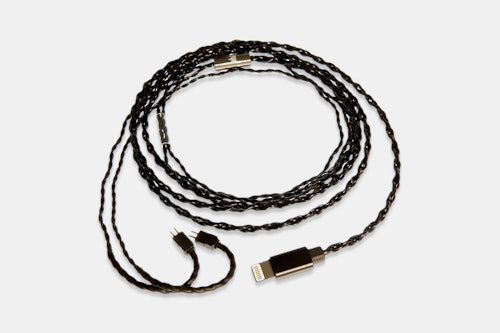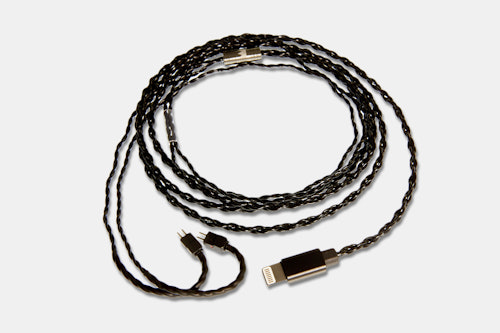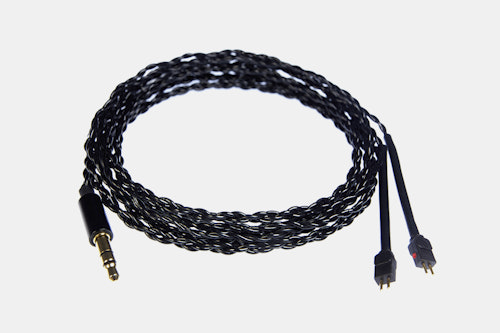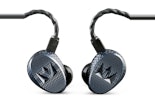Click to view our Accessibility Statement or contact us with accessibility-related questions$80$80
 VIEW 1 MORE
VIEW 1 MORE







Noble Audio 2-Pin to Lightning & 2.5mm Cables
$19
Noble Audio 2-Pin to Lightning & 2.5mm Cables
bookmark_border
$19
2k Sold
·
Ready to Ship
●
Members who purchase earn
19
Drop Rewards
Frequently bought together:
Want to know something about this product or how to use it?
Ask the community!
Ask the community!
Sort by: Newest
keyboard_arrow_down
BF_C
1
Aug 30, 2021
Hi Drop,
I would like to ask if the 2.5mm trrs was a balanced cable ?
Much thanks for your advice.
BF

ElectronicVices
2940
Aug 12, 2022
These days a 2.5mm TRRS is most commonly 'balanced' stereo. A TRRS cable can also be used for L/R+ microphone channel. This particular noble 2.5mm is a 'balanced' cable, but not every TRRS cable will be wired as such. Double check the description of any cable before your purchase.

Evshrug
4132
Keyboard Club Member
Aug 26, 2021
That’s more of a limitation of the Lightning port specifications, which I think is limited to 24/44 and 24/48. Sounds great though! I use my iPad hooked up to my $2400 DAC/amp and $1500 headphones because the output is bit-perfect, has less error introduced by computer EMI, and it sounds excellent with Apple Music lossless.
(Edited)

SuperFlyEDSguy
62
Dec 31, 2022
EvshrugHi @Evshrug 👋
I somehow just saw this. Actually, the DAC connects to the Lightening port, so modern Apple devices with newer versions of iOS (as it literally has the drivers) will pretty much scale-up to whatever you throw at it! The Atom-3 Portable DAC Amp is a great example as it has the ESS 9280 AC Pro baked into it, which supports pretty much everything you could imagine at 32/768 with the exception of MQA (as only the 9281 supports it). Actually, I’m likely going to get one for myself as Lightening-specific devices with these specs are seemingly very hard to come by. If you want those specs on a USB-C dongle, they’re everywhere, but I imagine that the lack thereof for Apple devices using the Lightening port connection has a lot to do with Apple’s MFi Certification Program as Apple publicly states, as you pointed out, that 24/48 is all you will ever need to enjoy HiFi sound on your Apple device, but is that really true?
As you already know, it’s not true, but not for the reasons most people think. See, when you get into the frequency response curves and the limitations of human perception, sure, you satisfy what the ears could physically hear. The “but” is that we humans may hear with our ears, but like vision too, our brain does the processing and does it very well. If you could see what your eyes directly see, you’d be amazed how the brain could process it as it’s filled with blur and holes!!! The ears are a bit more effective, but work in much the same way to collect the ‘raw audio data.’ The more ‘data’ you throw at it, the better that processing is as the brain is very good at detecting subtle nuances that would otherwise not be perceived at lower standards. More importantly, the more expensive the DAC — the better the specs — and things like SNR, THD, and Dynamic Range enter into the equation far better than they otherwise would! So, even if > 24/48 does not directly help, the added bonuses that come alongside a premium DAC certainly do!
Let’s not forget the marketing behind Apple’s 24/48 endorsement as mass-market DAC chips are a supply chain necessity to pump out $9 external DACs! Those absolutely mediocre DACs, e.g. Realtek, don’t suck, but they’re not intended for audiophile listening, but rather for the mass market that’s willing to pay $9 for a more ‘premium’ sound option. I’m certain the vast majority of these consumers have no idea that other options are even available!
You raised a good point on bit-perfect audio with almost no error, but you could spend far less to get this as the ESS 928x AC Pro Product Brief has a schematic showing that an external (relative to the DAC chip, but still inside the housing) Crystal Oscillator is actually required. The above DAC (Atom-3) is a great example as there should be almost no errors with such a setup! Cheap too! Yes, there’s the age old question that NwAvGuy claims that modern DACs don’t need external error correction as the bit-rates are well handled on contemporary equipment, and that may be true for some (or even most) hardware, but not when listening on a PC as the threads and slowdowns will inevitably lead to timing issues and error being introduced. I’m certain this is the case on other lower-end (read: not cheap) hardware as it’s been a long time since NwAvGuy was active and very rapid streaming such as MQA and DSD was either not yet available or not yet mainstream. When literally talking Megahertz (MHz), e.g. DSD technology, a Crystal Oscillator now becomes almost a requirement!
Summary:
I guess what I was trying to say is that the DAC is not onboard the Apple device itself, but it’s rather plugged into it via the Lightening port, and pretty much any bitrates are supported as the external DAC decides those specs. IMHO, a better DAC never hurts and finding one > 24/48 that plugs directly into the Lightening port is not easy to come by. As the Apple devices are good at music, but not music-specific devices, I would absolutely advocate for a premium DAC, but one within limits as anything too good will be an overkill for said device. The key is to remember that there are other specs and they do come with better hardware, so as long as the purchasing decision is a well balanced one, it should get a lot more out of your Apple device than even expected! —— Note: Edited for clarity.
Summary:
I guess what I was trying to say is that the DAC is not onboard the Apple device itself, but it’s rather plugged into it via the Lightening port, and pretty much any bitrates are supported as the external DAC decides those specs. IMHO, a better DAC never hurts and finding one > 24/48 that plugs directly into the Lightening port is not easy to come by. As the Apple devices are good at music, but not music-specific devices, I would absolutely advocate for a premium DAC, but one within limits as anything too good will be an overkill for said device. The key is to remember that there are other specs and they do come with better hardware, so as long as the purchasing decision is a well balanced one, it should get a lot more out of your Apple device than even expected! —— Note: Edited for clarity.
(Edited)

Evshrug
4132
Keyboard Club Member
Jan 1, 2023
SuperFlyEDSguyLove this reply; I hope everyone that sees it goes ahead and reads it. Clarity was good!

Evshrug
4132
Keyboard Club Member
Jan 1, 2023
SuperFlyEDSguyI had written a longer reply, but my login got timed out because I’m dealing with stuff at home 😅
One of those things is a shingles outbreak in my left eye right now; I’m all too familiar with how amazing our brains are at compensating for imperfect observation tools! Especially right after I wake up, it’s hazy… but after focusing on something for about 1-1.5 seconds, that object seems to sharpen up and it’s easier to see details. Then, I blink, and have to start over.
But! Our brains really are powerful perception processing tools! We’ve had incredible transducers in Headphones and Speakers for decades right now, and further leaps in sound “quality” or at least timbre and perception of resolution will be due to study and inspired application of psychoacoustics. This is how the AAC and I believe MP3 and other codecs were developed, plus Bose and other companies owe their success to psychoacoustics.
Back on DAC topic, I agree with everything you said and I feel you did a great job explaining. Audio really is an iceberg topic: almost everyone has an understanding of what to connect to make things work, but below the surface is an ice-mountain of info about how audio and our digital devices work. I don’t think enough people realize that the most common Digital to Analog Converters (DACs) are general purpose devices, many not even used for audio. Or that audio is streamed over digital connections like USB, so timing is crucial and data error correction isn’t possible in the same way packets of data with error correction are sent in a two-way communication with a printer or storage drive. And you’re right to point out that audio dongles combine amps and DACs (and filter software) into a tiny all-in-one device, which is then connected to the digital output of our mobile devices. So, when I connect my discrete DAC and amp to my iPad (I picked up a new one in 2022, an Air with USB-C) or my iPhone, I’m essentially using the same digital USB connection as a dongle, just with a physically different plug 🔌 and the desktop-sized unit benefitting from larger components.
I have a Windows and a Mac PC too, but I prefer to use my iPad or a streamer (like the WiiM Pro, looking forward to picking that up when it comes back in stock), because the stack of audio programming and power management in the mobile devices’ operating systems (and the streamers) use is more optimized for audio than the traditional PC’s. So, I would also recommend exploring higher end audio devices for sound quality benefits over the humble $9 dongles, which themselves are improvements over most motherboard and laptop integrated headphone outputs!

SuperFlyEDSguy
62
Jan 25, 2023
EvshrugFirst, thank you so much for the kind words, and I apologize for my delay in being able to respond. Unfortunately, my body goes through flares of inflammation as I deal with Ehlers-Danlos Syndrome and Chronic Fatigue. I’ve pretty much hit a ‘brick wall’ lately and have a fairly good idea as to what a being a zombie must feel like. 😂 On the note of ‘health,’ or lack thereof, I certainly hope your Shingles are doing better! I had them on my ribs a while back and can’t even imagine how infuriating it must be to have them in your eye! Wow! My heart definitely goes out to you!
I did figure that YOU of all people would already have a good understanding of the neuropsychological aspects of the human sensory system, e.g. that it handles MOST of it! 😂 So, when I write, I try to keep it understandable for the masses as we have folks of many levels who browse these forums.
Psychoacoustics honestly never ceases to amaze me! You raise some fine points regarding psychoacoustics specifically as the lossy codecs, for what they’re worth, were indeed created with the range of adult human hearing in mind. When you think about it, it’s pretty amazing that technologies such as the AAC and MP3 were created so long ago and did such a good job at entertaining the mass market, which was indeed their target goal at the time. These technologies were never meant to be ‘audiophile’ grade codecs as they were heavily geared towards extreme compression by removing what most adult humans cannot hear, e.g. 128kbps resulting in a file size that’s just ~9.07% of the CD version at 1411kbps! Even Dolby and DTS, which are BOTH LOSSY codecs, are capable of reducing the original PCM audio data by as much as 90%! 😮 With the rise of popularity of the perceived difference of lossless compression across mass market consumers, Dolby eventually released their Dolby Digital TrueHD technology and DTS did the same with DTS-HD Master Audio. Interestingly enough, the consumer audio industry estimates that adult human hearing tops off somewhere around 13kHz (give or take 1kHz), so by eliminating the bands over this it would free-up a ton of space that at least in theory would not be perceived. Bose took a sort of opposite route by enhancing the lows instead of cutting out the highs, but one pertains to speaker systems and the other to the codecs, something that must support one another to enjoy good sound.
Distortion comes into play when you try to ‘force’ channels that are not meant for the speaker playing them. So, HD equipment really is necessary to support HD encoded audio without resulting in distortion!
I personally find that CD Quality audio at 1411kbps when paired with a decent enough DAC and an output source (such as IEMs or headphones) are enough to make an amazing difference in the quality of the audio. I find that a fairly good analogy of this is chasing the speed of light as the faster you go, the harder it will become to gain additional speed. So, likewise with audio, I DO think some gain is produced by going balls to the wall, but it’s modest and expensive at that! This morning, for example, I was enjoying music on my ancient iPod Nano 2G as it has that really nice Wolfson DAC that Apple phased-out ages ago, when paired with 16-bit (and a few 24-bit) ALAC files and listening on my Beyerdynamic DT 770 Pro, well, it sounded amazing!
My point is that it doesn’t take much to get really good quality audio, but all the pieces must be present to do so! 😃👍
(Actually, I would specifically recommend the 32Ω version of the DT 770 Pro when listening with an iPod or iPhone as the lower impedance will be very helpful at ensuring adequate volume levels amongst other things!)
This is why I totally agree with your explanation of audio being an iceberg topic! Thank you again, BTW, for all the kind words regarding my explanation! I think that more people who truly want to enjoy audio need to obtain the basic technical knowledge on how audio really works. I find that when browsing online forums in general, I use my engineering knowledge to ‘put out fires’ far more often than I’d like. This is because when folks hear the wrong information, but don’t have the technical knowledge to challenge it, it tends to be repeated and repeated again.
A little technical knowledge will not only limit the amount of disinformation circling the internet in general, but really will make listening to and appreciating your music a far better experience! The funny thing is I also find that it doesn’t take much to really understand the more important aspects, maybe when I’m feeling up to it I could write a few posts debunking common audio poppycock. 😂
Lastly, I agree with those final few points of yours as I almost never listen to audio on a PC or Mac, primarily because it’s just not necessary to do so. My 15-ish-year-old iPod Nano plays ALAC files extremely well (and FLAC too with third party firmware), but again that’s thanks to the Wolfson DAC. Newer doesn’t mean better! The $9 DAC was created for the same mass market consumers that AAC and MP3 was originally intended for. If you want a better experience, I find that it doesn’t take much to get to ‘the next level.’ The Helm DAC is one of my favorite DACs for my iPhone right now! I have also found Chi-Fi DACS for $20 or $30 that sound freaking amazing! An amp is still almost always necessary as even those onboard the dongles are nothing special, they simply can’t be due to power constraints. I also personally enjoy a hardware EQ and JDS Labs makes a very nice one for under $100! The thing with an EQ is that you cannot only selectively amplify those desired bands, but cut those bands that are causing distortion on your speakers as I mentioned above! (Yes! EQs are technically amplifiers that use filters in conjunction with op-amps and potentiometers to achieve selective channel amplification!)
Creativity with your hardware goes a very long way! On that note, I am exhausted today, and must be going. I certainly hope you’re feeling better! Be well. ✌️
Creativity with your hardware goes a very long way! On that note, I am exhausted today, and must be going. I certainly hope you’re feeling better! Be well. ✌️
jbhatnagar00
22
Aug 25, 2021
Why use this when you can’t use the lightning-to-3.5 apple dongle with its DAC? That DAC is really good so missing that and plugging directly into an iPhone doesn’t make sense. Does this have cable have a DAC built in like the dongle?

Evshrug
4132
Keyboard Club Member
Aug 26, 2021
Well, the speakers/drivers in headphones or in-ears are analog devices, and a Lightning port is digital only, so yes this would have to have a built in DAC/amplifier. The Apple dongle does have a very good cost to value ratio (and benefits from some of the largest scale of manufacturing), but certainly the DAC and amplifier could be improved. It’s quite feasible that this cable “system” improves on Apple’s $9 dongle.
But I’ve never heard Noble’s product here, so I can’t make any specific comments 🤷♂️

ElectronicVices
2940
Aug 12, 2022
No, this is for 2-pin IEM's, Sennheiser uses a different connector for the 6 series (and other) headphones.





